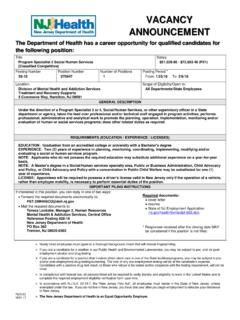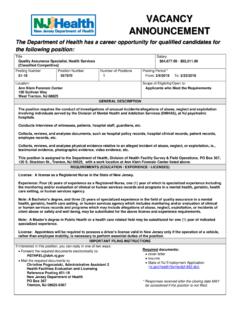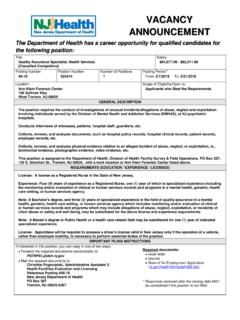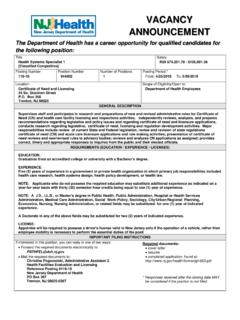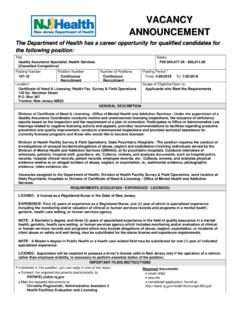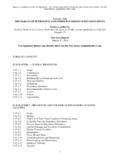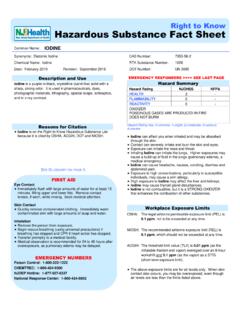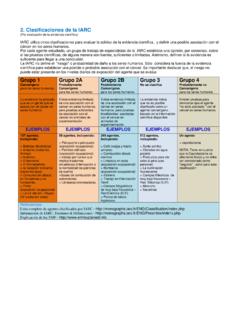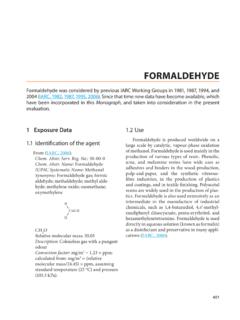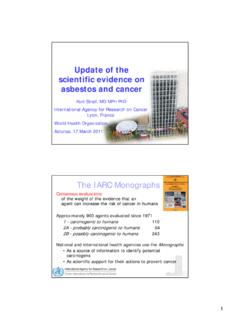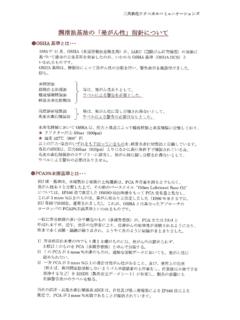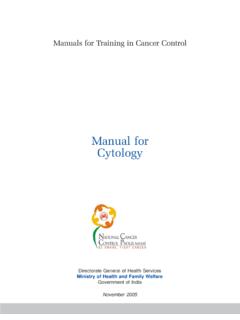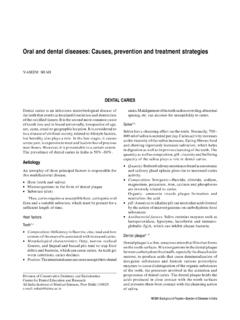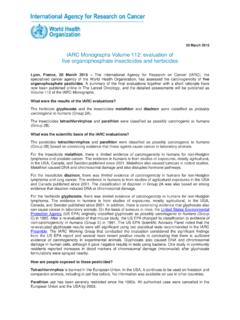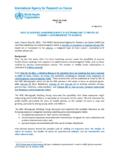Transcription of Right to Know Hazardous Substance Fact Sheet - …
1 Right to Know Hazardous Substance Fact Sheet Common Name: SULFUR DIOXIDE Synonyms: Sulfurous Oxide; Sulfur Oxide Chemical Name: Sulfur Dioxide Date: June 2000 Revision: May 2010 CAS Number: 7446-09-5 RTK Substance Number: 1759 DOT Number: UN 1079 Description and Use Sulfur Dioxide is a colorless gas with a strong, irritating odor, that is often shipped as a liquid under pressure. It is used as a bleaching agent, refrigerant, and solvent, and occurs as an off-gas from smelters and electrical power plants. f ODOR THRESHOLD = to 5 ppm f Odor thresholds vary greatly. Do not rely on odor alone to determine potentially Hazardous exposures. Reasons for Citation f Sulfur Dioxide is on the Right to Know Hazardous Substance List because it is cited by OSHA, ACGIH, DOT, NIOSH, DEP, IARC, NFPA and EPA.
2 SEE GLOSSARY ON PAGE 5. FIRST AID Eye Contact f Immediately flush with large amounts of water for at least 15 minutes, lifting upper and lower lids. Remove contact lenses, if worn, while flushing. Seek medical attention. Skin Contact f Immerse affected part in warm water. Seek medical attention. Inhalation f Remove the person from exposure. f Begin rescue breathing (using universal precautions) if breathing has stopped and CPR if heart action has stopped. f Transfer promptly to a medical facility. f Medical observation is recommended for 24 to 48 hours after overexposure, as pulmonary edema may be delayed. EMERGENCY NUMBERS Poison Control: 1-800-222-1222 CHEMTREC: 1-800-424-9300 NJDEP Hotline: 1-877-927-6337 National Response Center: 1-800-424-8802 EMERGENCY RESPONDERS >>>> SEE LAST PAGE Hazard Summary Hazard Rating NJDOH NFPA HEALTH - 3 FLAMMABILITY - 0 REACTIVITY - 0 POISONOUS GASES ARE PRODUCED IN FIRE CONTAINERS MAY EXPLODE IN FIRE DOES NOT BURN Hazard Rating Key: 0=minimal; 1=slight; 2=moderate; 3=serious.
3 4=severe f Sulfur Dioxide can affect you when inhaled and by passing through the skin. f Contact can irritate and burn the skin and eyes with possible eye damage. f Direct contact with the liquid may cause frostbite. f Inhaling Sulfur Dioxide can irritate the nose and throat. f Inhaling Sulfur Dioxide can irritate the lungs. Higher exposures may cause a build-up of fluid in the lungs (pulmonary edema), a medical emergency. f Repeated exposure can cause loss of sense of smell, headache, nausea and dizziness. Workplace Exposure Limits OSHA: The legal airborne permissible exposure limit (PEL) is 5 ppm averaged over an 8-hour workshift. NIOSH: The recommended airborne exposure limit (REL) is 2 ppm averaged over a 10-hour workshift and 5 ppm, not to be exceeded during any 15-minute work period.
4 ACGIH: The threshold limit value (TLV) is ppm averaged over an 8-hour workshift. f The above exposure limits are for air levels only. When skin contact also occurs, you may be overexposed, even though air levels are less than the limits listed above. SULFUR DIOXIDE Page 2 of 6 Determining Your Exposure f Read the product manufacturer s Material Safety Data Sheet (MSDS) and the label to determine product ingredients and important safety and health information about the product mixture. f For each individual Hazardous ingredient, read the New Jersey Department of Health Hazardous Substance Fact Sheet , available on the RTK website ( ) or in your facility s RTK Central File or Hazard Communication Standard file.
5 F You have a Right to this information under the New Jersey Worker and Community Right to Know Act and the Public Employees Occupational Safety and Health (PEOSH) Act if you are a public worker in New Jersey, and under the federal Occupational Safety and Health Act (OSHA) if you are a private worker. f The New Jersey Right to Know Act requires most employers to label chemicals in the workplace and requires public employers to provide their employees with information concerning chemical hazards and controls. The federal OSHA Hazard Communication Standard (29 CFR ) and the PEOSH Hazard Communication Standard ( 12:100-7) require employers to provide similar information and training to their employees.
6 This Fact Sheet is a summary of available information regarding the health hazards that may result from exposure. Duration of exposure, concentration of the Substance and other factors will affect your susceptibility to any of the potential effects described below. Health Hazard Information Acute Health Effects The following acute (short-term) health effects may occur immediately or shortly after exposure to Sulfur Dioxide: f Contact can irritate and burn the skin and eyes with possible eye damage. f Direct contact with the liquid may cause frostbite. f Inhaling Sulfur Dioxide can irritate the nose and throat. f Inhaling Sulfur Dioxide can irritate the lungs causing coughing and/or shortness of breath.
7 Higher exposures may cause a build-up of fluid in the lungs (pulmonary edema), a medical emergency, with severe shortness of breath. Chronic Health Effects The following chronic (long-term) health effects can occur at some time after exposure to Sulfur Dioxide and can last for months or years: Cancer Hazard f While Sulfur Dioxide has been tested, it is not classifiable as to its potential to cause cancer. Reproductive Hazard f Sulfur Dioxide may decrease fertility in males and females. Other Effects f Repeated exposure can cause loss of sense of smell, headache, nausea, vomiting and dizziness. f Sulfur Dioxide can irritate the lungs. Repeated exposure may cause bronchitis to develop with coughing, phlegm, and/or shortness of breath.
8 Medical Medical Testing For frequent or potentially high exposure (half the TLV or greater), the following are recommended before beginning work and at regular times after that: f Lung function tests Any evaluation should include a careful history of past and present symptoms with an exam. Medical tests that look for damage already done are not a substitute for controlling exposure. Request copies of your medical testing. You have a legal Right to this information under the OSHA Access to Employee Exposure and Medical Records Standard (29 CFR ). Mixed Exposures f Smoking can cause heart disease, lung cancer, emphysema, and other respiratory problems. It may worsen respiratory conditions caused by chemical exposure.
9 Even if you have smoked for a long time, stopping now will reduce your risk of developing health problems. Conditions Made Worse By Exposure f People with chronic lung disease (bronchitis, emphysema) may have their condition become worse after exposure to Sulfur Dioxide. SULFUR DIOXIDE Page 3 of 6 Workplace Controls and Practices Very toxic chemicals, or those that are reproductive hazards or sensitizers, require expert advice on control measures if a less toxic chemical cannot be substituted. Control measures include: (1) enclosing chemical processes for severely irritating and corrosive chemicals, (2) using local exhaust ventilation for chemicals that may be harmful with a single exposure, and (3) using general ventilation to control exposures to skin and eye irritants.
10 For further information on workplace controls, consult the NIOSH document on Control Banding at The following work practices are also recommended: f Label process containers. f Provide employees with hazard information and training. f Monitor airborne chemical concentrations. f Use engineering controls if concentrations exceed recommended exposure levels. f Provide eye wash fountains and emergency showers. f Wash or shower if skin comes in contact with a Hazardous material. f Always wash at the end of the workshift. f Change into clean clothing if clothing becomes contaminated. f Do not take contaminated clothing home. f Get special training to wash contaminated clothing.
